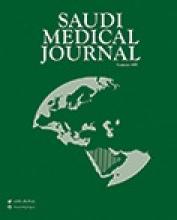To the Editor
I have read with interest the study, transcutaneous bilirubin measurement in healthy Saudi term newborns, by Alsaedi.1 Original research and outstanding milestone in measuring the neonatal jaundice. Almost all newborn infants develop a total serum or plasma bilirubin (TB) value greater than 1 mg/dL (17.1 micromole/L), which is the upper limit of normal for adults. As TB increases, it causes neonatal jaundice, the yellowish discoloration of the skin and/or conjunctiva caused by bilirubin deposition in half of all newborn infants. Dermal pressure may reveal the anatomic progression of jaundice, face 5 mg/dl, mid abdomen 15 mg/dl, Soles 20 mg/dl. But clinical examination cannot be dependent on to estimate serum levels.2 Neonates with severe hyperbilirubinemia (defined as a TB >25 mg/dL [428 micromole/L]) are at risk for bilirubin-induced neurologic dysfunction (BIND), which occurs when bilirubin crosses the blood-brain barrier and binds to brain tissue. In an observational study, 249 Egyptian neonates were self-referred to a public hospital neonatal intensive care unit (NICU) following unknown duration of hyperbilirubinemia after delivery at outlying facilities over a 12-month period (January to December 2008). Characteristics of this at-risk infant cohort included: gestational age (GA) >34 weeks, birth weight (BW) >2 kg, postnatal age <14 days, and admission TB ≥25 mg/dL (428 micromole/L). Of these, 44 (18%) were diagnosed with moderate or severe acute bilirubin encephalopathy (ABE), 55 (22%) with mild ABE, and the remaining infants were asymptomatic. Although the median TB was lower in patients with no ABE symptoms (28.3 mg/dL [484 micromole/L]) and rose progressively for those with mild/moderate and severe ABE (32 to 33 and 36.5 mg/dL, [547 to 564 and 624micromol/L]), the range of TB values was similar in all 3 groups. Of the 26 infants who died with evidence of ABE, 19 had a TB level ≥30 mg/dL (513 micromole/L). The 7 infants who died with lower TB had evidence of severe hemolysis and included 6 with Rhesus (Rh) incompatibility. In this select cohort of patients, multiple regression analyses demonstrated that sepsis, Rh incompatibility, and incremental TB increases of 5 mg/dL (86 micromole/L) increased the risk of ABE. In the neonate, TB values vary because of differences in racial composition, breast feeding practices, the prevalence.2 Of hemolytic conditions, and methodology of TB measurements. Major risk factors for severe hyperbilirubinemia are Pre discharge TB or transcutaneous bilirubin (TcB) >95th percentile for age, jaundice within the first 24 hours of life, hemolytic disease, gestational age (GA) <37 weeks, Sibling who previously received phototherapy, cephalohematoma or significant bruising. Exclusive breastfeeding, not going well.3,4 East Asian race hyperbilirubinemia is a common and in most cases benign problem in neonates. Transcutaneous bilirubin is a measurement of total serum bilirubin from an instrument that uses reflectance measurements on the skin and correlates well with the laboratory total serum bilirubin (TSB) value.5 Our experience in Saudi Arabia is that 2 main problems that the practicing doctor who handles such cases faces both in hospitals and primary health centers, especially in ministry of health: 1) Over crowd of the patients: 2) Inadequate trained staff in the laboratory especially during night duty to extract the blood from the neonate for bilirubin estimation.
In our opinion, transcutaneous bilirubin measurement is noninvasive technique this can partly solve the problem. Although there is need to conduct more such type of studies to assess the efficacy of this method. We agree with the author regarding the use of this instrument in daily practice for measurement of jaundice in neonates. All the medical centers dealing such cases especially Ministry of Health that handles major chunk of neonatal population should be provided this noninvasive instrument to run the work smoothly.
Reply from the Author
I would like to thank Dr. Nabi for his interest and comments on the paper. I agree with his comments. It is recommended to screen all newborns before discharge from the hospital for the risk of severe hyperbilirubinemia.6 This can be performed by measuring TSB or TcB level and plot the results on nomogram.7 However, the combination of predischarge TcB measurement with clinical risk factors improves the prediction of subsequent hyperbilirubinemia.3 Measurement of TSB is still the gold standard for jaundiced newborn infants. TcB measurement does not obviate the need for TSB measurement in infants who have rapidly rising bilirubin, hyperbilirubinemia in the first 24 hours of life or ill infants.
Saad Alsaedi
Department of Pediatrics Faculty of Medicine Jeddah Kingdom of Saudi Arabia
- Copyright: © Saudi Medical Journal
This is an open-access article distributed under the terms of the Creative Commons Attribution-Noncommercial-Share Alike 3.0 Unported, which permits unrestricted use, distribution, and reproduction in any medium, provided the original work is properly cited.






